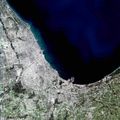Norridge, Illinois | |
|---|---|
| Motto: The Community of "Compassion, Care, Hope" | |
 Location of Norridge in Cook County, Illinois. | |
| Coordinates: 41°57′54″N87°49′26″W / 41.96500°N 87.82389°W | |
| Country | United States |
| State | Illinois |
| County | Cook |
| Township | Norwood Park |
| Government | |
| • President | Daniel Tannhauser |
| Area | |
• Total | 1.81 sq mi (4.68 km2) |
| • Land | 1.81 sq mi (4.68 km2) |
| • Water | 0 sq mi (0.00 km2) |
| Population (2020) | |
• Total | 15,251 |
| • Density | 8,436.6/sq mi (3,257.39/km2) |
| Time zone | UTC−6 (CST) |
| • Summer (DST) | UTC−5 (CDT) |
| ZIP Code | 60706 |
| Area codes | 708/464 |
| Website | www |
Norridge is a village in Norwood Park Township, Cook County, Illinois, United States. The village and its neighbor to the east, Harwood Heights, together form an enclave within the city of Chicago. Norridge is sometimes referred to as the "Island Within a City". The area that would eventually become Norridge was settled by farmers in 1830. The first names of what would become Norridge were "Goat Village", due to a local resident's goat farm, and "Swamp" due to a lack of streets and the area's swamp-like conditions. Norridge's early borders were Ozanam Ave, Olcott Avenue, Irving Park Road, and Montrose Avenue. In 1948, a local improvement association incorporated Norridge as a village, stymieing an effort by Chicago to annex the area.





